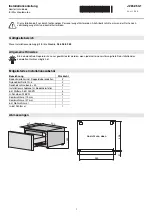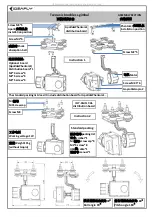
FAAST 8251BPI and 8100
INSTALLATION AND MAINTENANCE INSTRUCTIONS
2
Items Included with Unit
FAAST XM device
Mounting bracket
Mounting nuts (2) and washers (2)
3-pin terminal block
6 (8251BPI)
9 (8100)
4-pin terminal block
2 (8251BPI)
1 (8100)
47KΩ EOL Resistor
2 (8100 only)
Installation and Maintenance Instructions
PipeIQ software and a comprehensive instruction manual.
An advanced networking white paper may be downloaded
at www.systemsensor.com/faast
Figure 1: Wall Mounting Plate
INTRODUCTION
Scope of this Manual
This manual is intended as a guide for technicians to
install, set up and provide preliminary system checks for
the FAAST (Fire Alarm Aspiration Sensing Technology)
aspirating smoke detection system. Before installing,
please read the Comprehensive Instruction Manual for
the FAAST aspiration detection system (available on
PipeIQ CD or at SystemSensor.com/faast), which
provides detailed information on pipe design and system
configuration.
WARNING
The performance of the system depends on the designed
pipe network for the site. Any alteration to the pipe
network will alter the performance of the system and
must be verified by a technician. The PipeIQ® design
tool can be used to verify the suitability of any pipe
network design and subsequent alterations. The PipeIQ
software program is available from your distributor or can
be downloaded from systemsensor.com/faast.
DESCRIPTION
The 8000 Series FAAST XM aspirating smoke detection
system is an advanced particulate detection system for
use in early warning and very early warning applications.
The system continuously draws air from the controlled
environment through a series of sampling holes to
monitor the environment for smoke particulate.
FAAST system conditions are displayed at the user
interface and at a fire alarm control panel via relays.
System conditions can also be displayed remotely in two
ways through the network interface: integrated Web
server or PipeIQ software. The display provides a clear
indication of the system status, particulate levels, alarm
levels, air flow and faults. Additionally, e-mail notification
can be sent upon status changes. These can all be
discerned by monitoring the user interface at either the
local or remote display.
Features
Clip intelligent protocol (8251BPI only)
Advanced detection using blue LED and IR laser
technology
Monitors up to 1000m
2
(dependant on local code and
ordinances)
Wide sensitivity range of 0.0015% to 20.5% obs/m.
Programmable alarm thresholds and delays
Six (8251BPI)
or
eight (8100)
sets of relay contacts
Advanced dust discrimination for reduced false alarms
Air filtration
Particle separation for increased filter life
Electronic filter life monitoring
Ultrasonic air flow sensing
Field service access door
Easy access filter maintenance door
Event, service and trend logs
PipeIQ pipe modelling software
Acclimate mode operation for auto-adjustment of
sensitivity
Remote monitoring via Ethernet/IP
Remote reset/dry contact input
Multi-lingual support
Email notification of alarm, fault or isolate conditions
INSTALLATION
This equipment must be installed in accordance with all
local and national codes and regulations.
Pipe Installation
The pipe layout is designed using the PipeIQ software
package. Refer to the Comprehensive Instruction Manual
that comes with the PipeIQ software package to design
the pipe network. All pipe must be installed in accordance
with local and national codes and regulations.
The pipe network should be complete before proceeding
with the physical and electrical system installation.
Physical Unit Installation
Make sure that there are no pipes or electrical wires
within the wall before drilling any mounting holes.
Securing the Mounting Bracket
The typical mounting location for the FAAST unit is on a
wall. The unit is mounted to the wall using the enclosed
mounting plate. Figure 1 shows the wall mounting plate.
For easier access to the FAAST unit, it is preferred to
position the mounting plate in an easily accessible
location.
1.
Place the mounting bracket on the wall in the desired
location and use it as a template to locate the necessary
mounting holes.
2. Mark the hole locations and remove the bracket. It is
recommended to secure the bracket using the 4 outer
mounting holes.
3. Using a drill and the proper size bit for your mounting
hardware, drill the necessary holes.
4. Use appropriate fasteners to accommodate the mounting
surface and FAAST device weight.
5. Secure the bracket to the wall.
WARNING



































